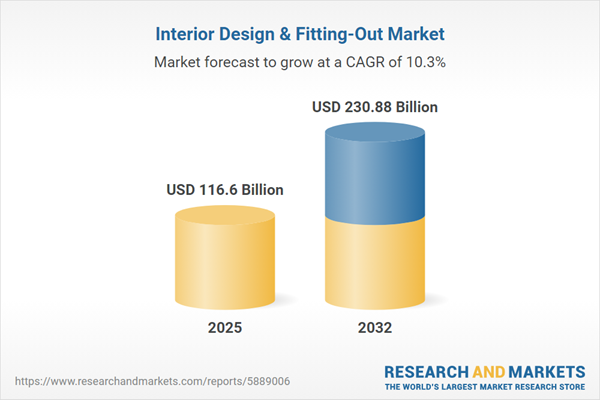Speak directly to the analyst to clarify any post sales queries you may have.
Organizations worldwide are focusing on interior design and fitting-out solutions that foster workplace agility, organizational resilience, and employee well-being. Senior decision-makers require tailored approaches that adapt to evolving business models and support long-term value creation.
Market Snapshot: Interior Design and Fitting-Out Market Size and Growth
The global interior design and fitting-out market is valued at USD 105.73 billion in 2024, with projections to reach USD 230.88 billion by 2032, reflecting a compound annual growth rate of 10.25%. Growth is being shaped by the adoption of agile workspace concepts, supported by flexible floor plans and digital project management. Organizations are increasingly aligning branded environments with employee-driven layouts, engaging advanced digital solutions to anticipate workplace trends, and strengthening their ability to adapt to diverse business needs. These shifts enable stakeholders to create future-ready commercial spaces that promote both strategic objectives and operational unity.
Scope & Segmentation of the Interior Design and Fitting-Out Market
- End User Segments: Commercial offices, coworking centers, educational institutions, healthcare organizations, retail environments, government buildings, residential complexes, hospitality venues, cultural facilities, and supermarkets. Each area has specific regulatory, branding, and operational demands that shape project strategy.
- Service Offerings: Design feasibility studies, compliance evaluation, schematic and spatial planning, specialist fitting-out for complex sites, turnkey management, budget oversight, and complete refurbishment to streamline delivery throughout all project stages.
- Component Types: Modular and custom furniture, advanced flooring systems, acoustic ceilings, specialized lighting, MEP components, and adaptive spatial dividers support productivity and meet sector-specific workplace needs.
- Project Types: New builds, large-scale refurbishments, selective upgrades, and workspace reconfigurations address changing business requirements and occupancy patterns.
- Contract Models: Procurement frameworks include design-bid-build, integrated design-build, and turnkey, providing varying levels of governance, efficiency, and project speed alignment.
- Geographical Coverage: The market spans the Americas, Europe, Middle East, Africa, and Asia-Pacific, with strategies refined to local regulations and cultural distinctions.
- Technologies: Building Information Modeling (BIM), digital twin integration, immersive visualization, IoT platforms, and modular or offsite construction are advancing project outcomes and cross-disciplinary coordination.
Key Takeaways for Senior Decision-Makers
- Integrated workspace strategies enable organizations to adapt flexibly to shifting requirements and set a cohesive direction for office investments.
- Leveraging digital solutions enhances planning precision, supports risk mitigation, and provides transparent communication across project stakeholders and leadership teams.
- Pursuing sustainable, ESG-aligned workspace development furthers long-term resilience and supports proactive risk management.
- Phased adoption of modular and offsite construction enables ongoing operations, reduces site disruption, and supports future growth scalability.
- Building stable regional supply chains and forming reliable supplier partnerships safeguards compliance and material sourcing amid changing regulatory environments.
- Collaboration with technical, IT, and material experts helps organizations address both local and multinational operational challenges efficiently.
Tariff Impact on Supply Chains and Costs
Recent tariffs in the United States affecting metals and wood panels have prompted organizations to enhance sourcing and revise inventory management strategies. Establishing robust supplier networks and flexible procurement agreements ensures greater cost predictability and delivery consistency. Modular assembly and established supplier relationships enable project teams to maintain standards and execution reliability in fluctuating economic environments.
Methodology & Data Sources
This B2B market research draws on interviews with architects, designers, project managers, and facility directors, combined with financial assessments and data from compliance standards. The analysis incorporates industry insights and findings from well-recognized research, ensuring relevance for strategic business leaders.
Why This Report Matters to Senior Decision-Makers
- Equips senior leadership to strategically plan, design, and implement adaptable workspaces that address sector-specific and regional demands.
- Supports capital planning and technology investments, reinforcing organizational readiness with reliable procurement and supply chain strategies.
- Translates evolving market trends into actionable operational improvements and effective real estate transformation initiatives.
Conclusion
This report guides decision-makers in aligning workspace development with current and emerging organizational needs. Leaders receive direction on technology, supply partnership, and quantifiable improvements as environments transform and grow more complex.
Additional Product Information:
- Purchase of this report includes 1 year online access with quarterly updates.
- This report can be updated on request. Please contact our Customer Experience team using the Ask a Question widget on our website.
Table of Contents
3. Executive Summary
4. Market Overview
7. Cumulative Impact of Artificial Intelligence 2025
Companies Mentioned
The companies profiled in this Interior Design & Fitting-Out market report include:- Gensler
- Perkins & Will
- IA Interior Architects, Inc.
- IBI Group Corporation
- AECOM, Inc.
- Stantec Inc.
- HOK Group, Inc.
- HKS, Inc.
- HDR, Inc.
- Jacobs Solutions Inc.
Table Information
| Report Attribute | Details |
|---|---|
| No. of Pages | 192 |
| Published | October 2025 |
| Forecast Period | 2025 - 2032 |
| Estimated Market Value ( USD | $ 116.6 Billion |
| Forecasted Market Value ( USD | $ 230.88 Billion |
| Compound Annual Growth Rate | 10.2% |
| Regions Covered | Global |
| No. of Companies Mentioned | 11 |









